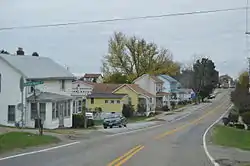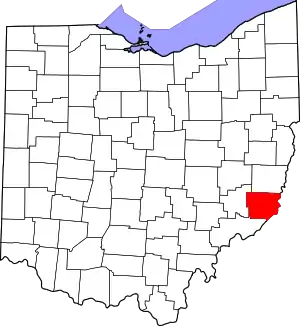Beallsville, Ohio | |
|---|---|
 | |
 Location of Beallsville, Ohio | |
 Location of Beallsville in Monroe County | |
| Coordinates: 39°50′54″N 81°2′7″W / 39.84833°N 81.03528°W | |
| Country | United States |
| State | Ohio |
| County | Monroe |
| Township | Sunsbury |
| Area | |
| • Total | 0.36 sq mi (0.94 km2) |
| • Land | 0.36 sq mi (0.94 km2) |
| • Water | 0.00 sq mi (0.00 km2) |
| Elevation | 1,257 ft (383 m) |
| Population (2020) | |
| • Total | 355 |
| • Density | 977.96/sq mi (377.77/km2) |
| Time zone | UTC-5 (Eastern (EST)) |
| • Summer (DST) | UTC-4 (EDT) |
| ZIP code | 43716 |
| Area code | 740 |
| FIPS code | 39-04542[3] |
| GNIS feature ID | 1075319[2] |
Beallsville (/ˈbɛlzvɪl/ BELLZ-vil[4]) is a village in Monroe County, Ohio, United States. As of the 2020 census, the population was 355. The village gained national attention by losing more than 1% of its population killed in action in the Vietnam War, the worst per-capita loss of life experienced by any place in the country.
Two former coal mines owned by Murray Energy, Powhatan No. 6 mine[5] and Century Mine,[6] are located near Beallsville.
History
During the period of active American participation in the Vietnam War in the 1960s, Beallsville gained brief notoriety for the loss of five of its citizens in the conflict — a traumatic rate of loss for the village of fewer than 500 residents that was estimated at 75 times the national average.[7] The plight of the community drew wire service coverage and was the subject of a lengthy illustrated spread in the glossy left-wing magazine Ramparts.[7] Moved by the magnitude of the loss, Congressman Clarence Miller made a formal request to Secretary of Defense Melvin Laird and President Richard Nixon to withdraw the village's other six servicemen from combat, which was denied.[7]
A sixth of the village's sons fell in combat on March 9, 1969, cementing the community's tragic distinction of having the highest percentage rate of loss in the Vietnam War of any town in America.[8]
Geography
Beallsville is located at 39°50′54″N 81°2′7″W / 39.84833°N 81.03528°W (39.848402, -81.035174).[9]
According to the United States Census Bureau, the village has a total area of 0.36 square miles (0.93 km2), all of it land.[10]
Demographics
| Census | Pop. | Note | %± |
|---|---|---|---|
| 1830 | 50 | — | |
| 1840 | 100 | 100.0% | |
| 1850 | 276 | 176.0% | |
| 1870 | 324 | — | |
| 1880 | 391 | 20.7% | |
| 1890 | 512 | 30.9% | |
| 1900 | 554 | 8.2% | |
| 1910 | 564 | 1.8% | |
| 1920 | 555 | −1.6% | |
| 1930 | 479 | −13.7% | |
| 1940 | 450 | −6.1% | |
| 1950 | 410 | −8.9% | |
| 1960 | 441 | 7.6% | |
| 1970 | 452 | 2.5% | |
| 1980 | 601 | 33.0% | |
| 1990 | 464 | −22.8% | |
| 2000 | 423 | −8.8% | |
| 2010 | 409 | −3.3% | |
| 2020 | 355 | −13.2% | |
| U.S. Decennial Census[11][12] | |||
2010 census
As of the census[13] of 2010, there were 409 people, 174 households, and 113 families living in the village. The population density was 1,136.1 inhabitants per square mile (438.7/km2). There were 196 housing units at an average density of 544.4 per square mile (210.2/km2). The racial makeup of the village was 97.8% White and 2.2% from two or more races.
There were 174 households, of which 31.6% had children under the age of 18 living with them, 43.7% were married couples living together, 13.2% had a female householder with no husband present, 8.0% had a male householder with no wife present, and 35.1% were non-families. 30.5% of all households were made up of individuals, and 12.6% had someone living alone who was 65 years of age or older. The average household size was 2.35 and the average family size was 2.90.
The median age in the village was 39.8 years. 22.5% of residents were under the age of 18; 9.1% were between the ages of 18 and 24; 25.9% were from 25 to 44; 29.1% were from 45 to 64; and 13.4% were 65 years of age or older. The gender makeup of the village was 48.9% male and 51.1% female.
2000 census
As of the census[3] of 2000, there were 423 people, 171 households, and 114 families living in the village. The population density was 1,145.5 inhabitants per square mile (442.3/km2). There were 186 housing units at an average density of 503.7 per square mile (194.5/km2). The racial makeup of the village was 98.35% White, 0.24% Pacific Islander, and 1.42% from two or more races. Hispanic or Latino of any race were 0.24% of the population.
There were 171 households, out of which 32.2% had children under the age of 18 living with them, 49.7% were married couples living together, 11.7% had a female householder with no husband present, and 33.3% were non-families. 29.2% of all households were made up of individuals, and 14.6% had someone living alone who was 65 years of age or older. The average household size was 2.47 and the average family size was 3.05.
In the village, the population was spread out, with 24.3% under the age of 18, 12.5% from 18 to 24, 28.6% from 25 to 44, 22.9% from 45 to 64, and 11.6% who were 65 years of age or older. The median age was 33 years. For every 100 females there were 85.5 males. For every 100 females age 18 and over, there were 83.9 males.
The median income for a household in the village was $25,893, and the median income for a family was $34,063. Males had a median income of $26,750 versus $20,938 for females. The per capita income for the village was $20,672. About 11.9% of families and 18.1% of the population were below the poverty line, including 15.0% of those under age 18 and 13.6% of those age 65 or over.
Notable people
- Merriman Colbert Harris, Civil War soldier and Methodist Episcopal Church Missionary Bishop
- Dustin Nippert, professional baseball player[14]
Footnotes
- ↑ "ArcGIS REST Services Directory". United States Census Bureau. Retrieved September 20, 2022.
- 1 2 "US Board on Geographic Names". United States Geological Survey. October 25, 2007. Retrieved January 31, 2008.
- 1 2 "U.S. Census website". United States Census Bureau. Retrieved January 31, 2008.
- ↑ "E.W. Scripps School of Journalism Ohio Pronunciation Guide | Ohio University". www.ohio.edu. Ohio University. 2016. Retrieved October 22, 2022.
- ↑ Junkins, Casey (August 23, 2017). "Murray Energy Powhatan No. 6 Mine Officially Closed Near Beallsville". Wheeling News-Register. Retrieved August 23, 2017.
- ↑ Defrank, Robert A. (May 5, 2022). "Century Mine To Close in June; More Than 100 Jobs To Be Lost". The Intelligencer and Wheeling News Register. Archived from the original on May 5, 2022. Retrieved May 8, 2023.
- 1 2 3 Jeffrey Blankfort, "Our Town: The War Comes Home to Beallsville, Ohio," Ramparts [San Francisco], vol. 8, no. 1 (July 1969), pp. 39-46.
- ↑ Ohio Historical Society. "Remarkable Ohio." Archived 2015-09-24 at the Wayback Machine Dead link, originally accessed February 26, 2007.
- ↑ "US Gazetteer files: 2010, 2000, and 1990". United States Census Bureau. February 12, 2011. Retrieved April 23, 2011.
- ↑ "US Gazetteer files 2010". United States Census Bureau. Archived from the original on January 25, 2012. Retrieved January 6, 2013.
- ↑ "Census of Population and Housing". Census.gov. Retrieved June 4, 2015.
- ↑ "Profile of General Population and Housing Characteristics: 2010 Demographic Profile Data (DP-1): Beallsville village, Ohio". United States Census Bureau. Retrieved May 31, 2012.
- ↑ "U.S. Census website". United States Census Bureau. Retrieved January 6, 2013.
- ↑ "INNERview Ep109 Dustin Nippert, the "Ace" on the mound". YouTube.
